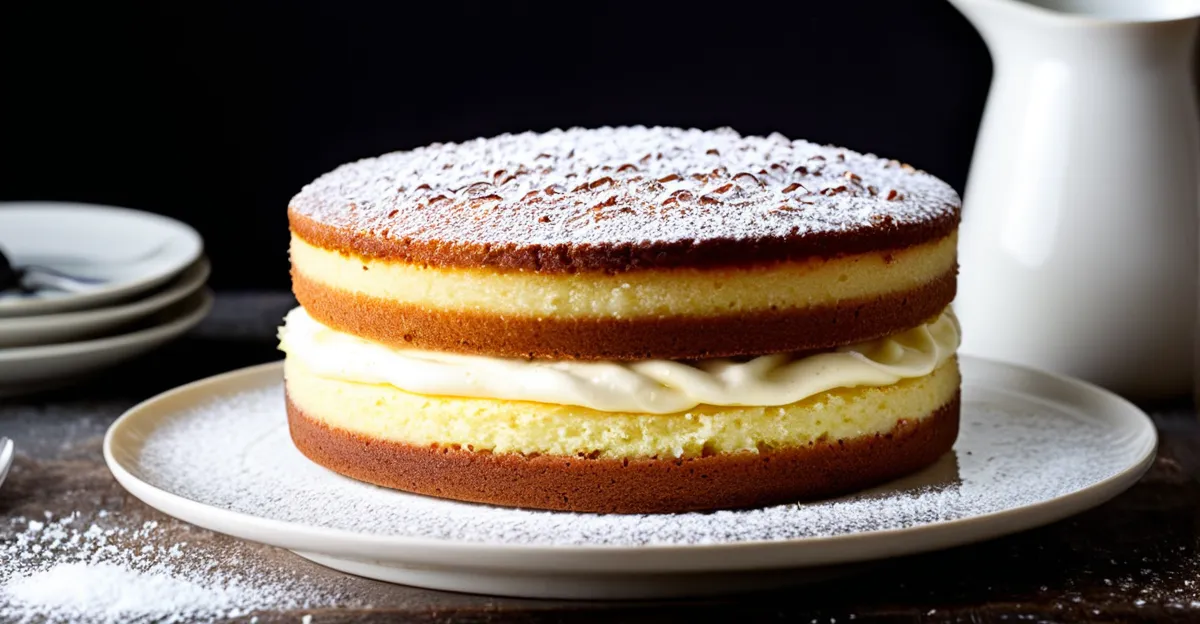Essential ingredients for a moist Victoria sponge cake
Understanding the importance of Victoria sponge cake ingredients is crucial for achieving a moist, tender crumb. The choice between butter and margarine significantly impacts texture. Butter adds a rich flavour and promotes a fine crumb, while margarine, which contains more water, can yield a softer but less flavorful cake. For ultimate moisture, high-quality unsalted butter is usually preferred.
Eggs play a vital role—both in quantity and quality. Typically, large eggs are recommended for standard recipes, as they provide consistency in moisture and structure. Using fresh eggs enhances emulsification, binding fats and liquids effectively to trap air. This combination improves the cake’s rise and moistness.
Also to discover : What are the best practices for crafting a classic fish and chips?
Sugar influences moisture retention too. Caster sugar is ideal because it dissolves quickly, helping to tenderize the crumb. The amount is just as important; too little leads to dryness, while excess can make the cake gummy. Balancing these ingredients carefully creates the foundation of a beautifully moist Victoria sponge cake.
Precise mixing techniques
Mastering how each step affects your Victoria sponge cake’s texture
Topic to read : What are the best ways to cook a succulent roast beef with all the trimmings?
The mixing methods used directly influence cake moisture and crumb structure. Start by creaming butter and sugar together until the mixture is pale and fluffy. This process traps air, creating optimal aeration essential for a light, moist sponge. Over-creaming or under-creaming can disrupt this balance, leading to denser cakes.
When adding eggs, incorporate them gradually to prevent curdling and maintain the emulsion, which helps retain moisture. Fresh, room-temperature eggs blend better with the butter-sugar mix, enhancing consistency. Also, avoid overmixing after adding flour; excessive mixing develops gluten, resulting in a tougher texture instead of the desired tender crumb.
Sifting dry ingredients, specifically flour and baking powder, ensures an even texture by removing lumps and mixing ingredients thoroughly. This step supports uniform rising and moisture distribution throughout the cake. Using these cake batter tips carefully can dramatically improve your sponge’s softness and moistness.
By focusing on these crucial mixing methods, you activate baking secrets that transform basic ingredients into a perfectly moist Victoria sponge cake.
Baking time and temperature management
Ensuring a perfectly baked, moist Victoria sponge cake
Proper bake time and cake oven temperature are critical baking secrets for preserving moisture in your Victoria sponge cake. Always preheat your oven fully to the recommended temperature before placing the cake inside; this guarantees an immediate and even rise, which helps trap moisture.
Position the cake in the middle rack of the oven to ensure uniform heat distribution. If placed too high or too low, parts may cook unevenly, causing dryness. Adjust your cake oven temperature according to your oven’s calibration; some ovens run hotter and may require slightly lowering the temperature to avoid overbaking.
To test for cake doneness, insert a skewer or toothpick into the centre of the cake. If it comes out clean or with a few moist crumbs, the cake is ready. Avoid testing too early to prevent collapse from underbaking or leaving the cake too long, which dries it out.
When cooling, keep the cake in its tin for about 10 minutes, then transfer to a wire rack. This method prevents sudden moisture loss by allowing gradual cooling while retaining internal steam, a key factor for cake moisture retention.
Advanced tips for maximizing cake moisture
Practical baking hacks to keep your Victoria sponge irresistibly moist
One of the most effective cake moisture retention techniques is applying a light brushing of cake syrup. Cake syrup, usually made from sugar and water or flavored extracts, penetrates the sponge, locking in moisture and adding a subtle sweetness. To apply, use a pastry brush and gently soak the surface immediately after baking and cooling slightly. This method significantly improves texture, especially if your sponge feels slightly dry.
Proper storage is vital to prevent dryness. After cooling completely, wrap the sponge tightly in cling film or store it in an airtight container. This traps residual moisture and protects the cake from air exposure that causes drying. Avoid refrigeration unless necessary, as fridges can dry out cakes despite moisture entrapment.
Be mindful of common baking mistakes that lead to dryness: overbaking, under-mixing, or using low-fat margarine instead of butter. Recognizing these missteps helps in adapting your process for a perfectly moist Victoria sponge cake. Employ these practical baking hacks to elevate your baking game and keep your sponge delectably soft and moist.
Quick reference: Actionable checklist for a moist Victoria sponge
A concise guide highlighting essential baking steps
To ensure a perfectly moist Victoria sponge, precise attention to ingredient measurements is crucial. Use quality butter rather than margarine to enhance richness and texture. Opt for fresh, large eggs to maintain moisture and structure consistently. Measure sugar accurately—too little causes dryness; too much results in a gummy crumb.
Follow step-by-step mixing methods carefully: cream butter and sugar until pale and fluffy to trap air. Add eggs gradually at room temperature to preserve the emulsion, then fold in sifted flour gently to avoid gluten overdevelopment. These cake batter tips are key for a light, moist sponge.
Maintain correct bake time and cake oven temperature settings—preheat fully and place the cake centrally to ensure even rising and moisture retention. Test doneness with a skewer only when nearing the end of baking to avoid drying out.
For storage, wrap your cooled cake tightly in cling film or place it in an airtight container. This prevents moisture loss over time, preserving the sponge’s softness. Use this baking checklist as a reliable reference to produce moist, tender Victoria sponge cakes every time.


